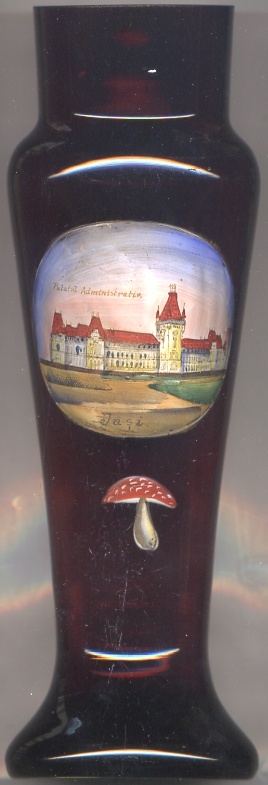

|
| ROMÂNIA | ROMANIA |
| județ Iași | Iași County |
 Iași is situated at an elevation of 60 m in the northeast of Romania, about 20 km west of the border to Moldavia.
Known as 'The Cultural Capital of Romania', Iași is a symbol in Romanian history.
Still referred to as 'The Moldavian Capital', Iași is the seat of Iași County and the main economic centre of the Romanian region of Moldavia.
As of 2011, Iași itself has a population of about 263,400 (the fourth most populous Romanian city), the metropolitan area is home to about 350,000 residents,
while the population of the peri-urban area exceeds 500,000 residents.
Iași is situated at an elevation of 60 m in the northeast of Romania, about 20 km west of the border to Moldavia.
Known as 'The Cultural Capital of Romania', Iași is a symbol in Romanian history.
Still referred to as 'The Moldavian Capital', Iași is the seat of Iași County and the main economic centre of the Romanian region of Moldavia.
As of 2011, Iași itself has a population of about 263,400 (the fourth most populous Romanian city), the metropolitan area is home to about 350,000 residents,
while the population of the peri-urban area exceeds 500,000 residents.
The name of the city is first officially mentioned in a document about a commercial privilege granted by the Moldavian Prince (Voivode) Alexandru cel Bun (Alexander the Good) to the Polish merchants of L'viv in 1408. However, as buildings older than 1408 existed and still exist it is believed that the city existed long before its first mentioning. Around 1564 the capital of Moravia was moved from Suceava to Iași. The city was burned down by the Tatars in 1513, by the Ottomans in 1538, and by Imperial Russian troops in 1686. In 1734, it was hit by the plague. Through the Peace of Iași, the sixth Russo-Turkish War was brought to a close in 1792. Until 1859, the city remained the capital of Moldavia; then, between 1859 and 1862, both Iași and Bucharest were de-facto capitals of the United Principalities of Moldavia and Wallachia. In 1862, when the union of the two principalities was recognized under the name of Romania, the national capital was established in Bucharest. During World War I, Iași was the capital of a severely reduced Romania for two years, following the Central Powers' occupation of Bucharest on 6 December 1916. The capital was returned to Bucharest after the defeat of Imperial Germany and its allies in November 1918. In November-December 1918 Iași hosted the Jassy Conference. During World War II more than 13,000 Jews, about one third of the Jewish population were killed during the Iași pogrom of 29 June to 6 July 1941 or in its aftermath, and many were deported. In May 1944, the Iași area became the scene of ferocious fighting between Romanian-German forces and the advancing Soviet Red Army and the city was partially destroyed.
The  Palace of Culture (Palatul Culturii) [left]
served as Administrative Palace and then Palace of Justice until 1955, when its destination was changed again, being assigned to the four museums nowadays united under
the name of Moldova National Museum Complex. Also, the building houses the Cultural Heritage Conservation-Restoration Centre, the main branch of the
Iași County Library (named after poet Gheorghe Asachi) and hosts various exhibitions and other events.
The construction, started in 1906, was partly built on the old ruins of the medieval Royal Court of Moldavia (1434), and partly on top of the foundations of the former
neoclassical style palace (1806), which was dismantled in 1904. The Romanian architect Ion D. Berindey was assigned to plan the building and he designed it in
flamboyant neo-Gothic style. During World War I, the construction halted due to the limitation of resources. The monument was inaugurated on 11 October 1925
by King Ferdinand of Romania.
Palace of Culture (Palatul Culturii) [left]
served as Administrative Palace and then Palace of Justice until 1955, when its destination was changed again, being assigned to the four museums nowadays united under
the name of Moldova National Museum Complex. Also, the building houses the Cultural Heritage Conservation-Restoration Centre, the main branch of the
Iași County Library (named after poet Gheorghe Asachi) and hosts various exhibitions and other events.
The construction, started in 1906, was partly built on the old ruins of the medieval Royal Court of Moldavia (1434), and partly on top of the foundations of the former
neoclassical style palace (1806), which was dismantled in 1904. The Romanian architect Ion D. Berindey was assigned to plan the building and he designed it in
flamboyant neo-Gothic style. During World War I, the construction halted due to the limitation of resources. The monument was inaugurated on 11 October 1925
by King Ferdinand of Romania.
[https://de.wikipedia.org/wiki/Iași, https://de.wikipedia.org/wiki/Iași, http://en.wikipedia.org/wiki/Palace_of_Culture_(Iași)]
![[scale]](lineal.jpg)